
Campanian
Encyclopedia
The Campanian is, in the ICS
' geologic timescale, the fifth of six ages of the Late Cretaceous
epoch
(or, in chronostratigraphy
: the fifth of six stages in the Upper Cretaceous series
). The Campanian spans the time from 83.5 ± 0.7 Ma to 70.6 ± 0.6 Ma (million years ago). It is preceded by the Santonian
and it is followed by the Maastrichtian
.
village of Champagne
in the département Charente-Maritime
. The original type locality
was an outcrop
near the village of Aubeterre-sur-Dronne
in the same region. Due to changes of the stratigraphic definitions, this section is now part of the Maastrichtian
stage.
The base of the Campanian stage is laid at the extinction
of crinoid
species Marsupites testudinarius
. A GSSP had not yet been ratified in 2009. One possible candidate is in a section near a dam at Waxahachie, Texas
.
The top of the Campanian is defined as the place in the stratigraphic column were the ammonite
Pachydiscus neubergicus
first appears.
, the Campanian encompasses six ammonite biozone
s. They are, from young to old:
among dinosaur
species occurred. In North America, for example, the number of known dinosaur genera
rises from 4 at the base of the Campanian to 48 in the upper part. This development is sometimes referred to as the "Campanian Explosion". However, it is not yet clear if the event is artificial, i.e. the low number of genera in the lower Campanian can be caused by a lower preservation chance for fossils in deposits of that age. The generally warm climates and large continental area covered in shallow sea during the Campanian probably favoured the dinosaurs. In the following Maastrichtian stage, the number of North American dinosaur genera found is 30% less than in the upper Campanian.
Animals that lived in the Campanian include:
International Commission on Stratigraphy
The International Commission on Stratigraphy , sometimes referred to by the unofficial "International Stratigraphic Commission" is a daughter or major subcommittee grade scientific daughter organization that concerns itself with stratigraphy, geological, and geochronological matters on a global...
' geologic timescale, the fifth of six ages of the Late Cretaceous
Late Cretaceous
The Late Cretaceous is the younger of two epochs into which the Cretaceous period is divided in the geologic timescale. Rock strata from this epoch form the Upper Cretaceous series...
epoch
Epoch (geology)
An epoch is a subdivision of the geologic timescale based on rock layering. In order, the higher subdivisions are periods, eras and eons. We are currently living in the Holocene epoch...
(or, in chronostratigraphy
Chronostratigraphy
Chronostratigraphy is the branch of stratigraphy that studies the age of rock strata in relation to time.The ultimate aim of chronostratigraphy is to arrange the sequence of deposition and the time of deposition of all rocks within a geological region, and eventually, the entire geologic record of...
: the fifth of six stages in the Upper Cretaceous series
Series (stratigraphy)
Series are subdivisions of rock layers made based on the age of the rock and corresponding to the dating system unit called an epoch, both being formally defined international conventions of the geological timescale. A series is therefore a sequence of rock depositions defining a...
). The Campanian spans the time from 83.5 ± 0.7 Ma to 70.6 ± 0.6 Ma (million years ago). It is preceded by the Santonian
Santonian
The Santonian is an age in the geologic timescale or a chronostratigraphic stage. It is a subdivision of the Late Cretaceous epoch or Upper Cretaceous series. It spans the time between 85.8 ± 0.7 mya and 83.5 ± 0.7 mya...
and it is followed by the Maastrichtian
Maastrichtian
The Maastrichtian is, in the ICS' geologic timescale, the latest age or upper stage of the Late Cretaceous epoch or Upper Cretaceous series, the Cretaceous period or system, and of the Mesozoic era or erathem. It spanned from 70.6 ± 0.6 Ma to 65.5 ± 0.3 Ma...
.
Stratigraphic definition
The Campanian was introduced in scientific literature by Henri Coquand in 1857. It is named after the FrenchFrance
The French Republic , The French Republic , The French Republic , (commonly known as France , is a unitary semi-presidential republic in Western Europe with several overseas territories and islands located on other continents and in the Indian, Pacific, and Atlantic oceans. Metropolitan France...
village of Champagne
Champagne, Charente-Maritime
Champagne is a commune in the Charente-Maritime department in southwestern France.-Population:-References:*...
in the département Charente-Maritime
Charente-Maritime
Charente-Maritime is a department on the west coast of France named after the Charente River.- History :Previously a part of Saintonge, Charente-Inférieure was one of the 83 original departments created during the French Revolution on 4 March 1790...
. The original type locality
Type locality (geology)
Type locality , also called type area or type locale, is the where a particular rock type, stratigraphic unit, fossil or mineral species is first identified....
was an outcrop
Outcrop
An outcrop is a visible exposure of bedrock or ancient superficial deposits on the surface of the Earth. -Features:Outcrops do not cover the majority of the Earth's land surface because in most places the bedrock or superficial deposits are covered by a mantle of soil and vegetation and cannot be...
near the village of Aubeterre-sur-Dronne
Aubeterre-sur-Dronne
Aubeterre-sur-Dronne is a commune in the Charente department in the Poitou-Charentes region in southwestern France.-Geography:The town is situated on the Dronne river, on the South-East border of the Charente region, close to the Dordogne and the villages of Bonnes, Laprade and Saint-Romain...
in the same region. Due to changes of the stratigraphic definitions, this section is now part of the Maastrichtian
Maastrichtian
The Maastrichtian is, in the ICS' geologic timescale, the latest age or upper stage of the Late Cretaceous epoch or Upper Cretaceous series, the Cretaceous period or system, and of the Mesozoic era or erathem. It spanned from 70.6 ± 0.6 Ma to 65.5 ± 0.3 Ma...
stage.
The base of the Campanian stage is laid at the extinction
Extinction
In biology and ecology, extinction is the end of an organism or of a group of organisms , normally a species. The moment of extinction is generally considered to be the death of the last individual of the species, although the capacity to breed and recover may have been lost before this point...
of crinoid
Crinoid
Crinoids are marine animals that make up the class Crinoidea of the echinoderms . Crinoidea comes from the Greek word krinon, "a lily", and eidos, "form". They live both in shallow water and in depths as great as 6,000 meters. Sea lilies refer to the crinoids which, in their adult form, are...
species Marsupites testudinarius
Marsupites
Marsupites is an extinct genus of crinoid from the Cretaceous.-Sources:* Fossils by David Ward...
. A GSSP had not yet been ratified in 2009. One possible candidate is in a section near a dam at Waxahachie, Texas
Waxahachie, Texas
Waxahachie is a city in Ellis County, Texas, United States, and a southern suburb of Dallas. The population was 21,426 at the 2000 census. It is the county seat of Ellis County....
.
The top of the Campanian is defined as the place in the stratigraphic column were the ammonite
Ammonite
Ammonite, as a zoological or paleontological term, refers to any member of the Ammonoidea an extinct subclass within the Molluscan class Cephalopoda which are more closely related to living coleoids Ammonite, as a zoological or paleontological term, refers to any member of the Ammonoidea an extinct...
Pachydiscus neubergicus
Pachydiscus
Pachydiscus is an extinct ammonite genus from the Upper Cretaceous with a world-wide distribution, and type for the desmoceratacean family Pachydiscidae. Its type is P. neubergicus. Altogether some 28 species have been described....
first appears.
Subdivision
The Campanian is sometimes subdivided into Lower, Middle and Upper subages. In the Tethys domainTethys Ocean
The Tethys Ocean was an ocean that existed between the continents of Gondwana and Laurasia during the Mesozoic era before the opening of the Indian Ocean.-Modern theory:...
, the Campanian encompasses six ammonite biozone
Biozone
Biostratigraphic units or Biozones are intervals of geological strata that are defined on the basis of their characteristic fossil taxa....
s. They are, from young to old:
- zone of Nostoceras hyattiNostocerasNostoceras is an extinct genus of ammonite from the Nostoceratidae family....
- zone of Didymoceras chayennenseDidymocerasDidymoceras is an extinct genus of ammonite cephalopod. It is one of the most bizarrely shaped genera, with a shell that spirals upwards into a loose, hooked tip...
- zone of Bostrychoceras polyplocumBostrychocerasBostrychoceras is a genus of ammonite from the Late Cretaceous. Its fossils have been found in Europe and North America.- Sources :* Ammonoid Paleobiology by Neil H. Landman, Kazushige Tanabe, and Richard Arnold Davis...
- zone of Hoplitoplacenticeras marroti/Hoplitoplacenticeras vari
- zone of Delawarella delawarensis
- zone of Placenticeras bidorsatumPlacenticerasPlacenticeras is an ammonite genus from the Late Cretaceous. Its fossils have been found in Asia, Europe, North and South America.-Taxonomy:...
Paleontology
During the Campanian age, a radiationRadiation
In physics, radiation is a process in which energetic particles or energetic waves travel through a medium or space. There are two distinct types of radiation; ionizing and non-ionizing...
among dinosaur
Dinosaur
Dinosaurs are a diverse group of animals of the clade and superorder Dinosauria. They were the dominant terrestrial vertebrates for over 160 million years, from the late Triassic period until the end of the Cretaceous , when the Cretaceous–Paleogene extinction event led to the extinction of...
species occurred. In North America, for example, the number of known dinosaur genera
Genera
Genera is a commercial operating system and development environment for Lisp machines developed by Symbolics. It is essentially a fork of an earlier operating system originating on the MIT AI Lab's Lisp machines which Symbolics had used in common with LMI and Texas Instruments...
rises from 4 at the base of the Campanian to 48 in the upper part. This development is sometimes referred to as the "Campanian Explosion". However, it is not yet clear if the event is artificial, i.e. the low number of genera in the lower Campanian can be caused by a lower preservation chance for fossils in deposits of that age. The generally warm climates and large continental area covered in shallow sea during the Campanian probably favoured the dinosaurs. In the following Maastrichtian stage, the number of North American dinosaur genera found is 30% less than in the upper Campanian.
Animals that lived in the Campanian include:
†Ankylosaurs
| Ankylosaurs of the Campanian | ||||
|---|---|---|---|---|
| Taxa | Presence | Location | Description | Images |
Aletopelta Aletopelta Aletopelta coombsi was an ankylosaurian ornithischian dinosaur whose fossils were found in Southern California.Etymologically, the generic name is composed of the Greek terms aletes and pelte, meaning, respectively "wandering" and "shield"... |
Point Loma Formation Point Loma Formation The Point Loma Formation is a sedimentary geological formation in Southern California. The strata date back to the Late Cretaceous. The formation is named after Point Loma, California.-Description:... , California, USA |
A medium-sized ankylosaurid, estimated to be around 6 m (20 ft) long | 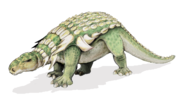   |
|
Antarctopelta Antarctopelta Antarctopelta was a genus of ankylosaurian dinosaur with one known species, A. oliveroi, which lived in Antarctica during the Late Cretaceous Period. It was a medium-sized ankylosaur, reaching no more than 4 meters in length, and showed characteristics of two different families, making more... |
Santa Marta Formation Santa Marta Formation The Santa Marta Formation is a geologic formation in Antarctica. It, along with the Mount Kirkpatrick Formation and the Snow Hill Island Formation, are the only formations yet known on the continent where dinosaur fossils have been found. The formation outcrops on James Ross Island off the coast of... , James Ross Island, Antarctica |
A stocky ankylosaur protected by armor plates embedded in the skin. Although a complete skeleton has not been found, the species is estimated to have reached a maximum length of 4 meters (13 ft). Displays characteristics of both ankylosaurids and nodosaurids | ||
Edmontonia Edmontonia Edmontonia was an armoured dinosaur, a part of the nodosaur family from the Late Cretaceous Period. It is named after the Edmonton Formation , the unit of rock it was found in.-Description:... |
Campanian to Maastrichtian Maastrichtian The Maastrichtian is, in the ICS' geologic timescale, the latest age or upper stage of the Late Cretaceous epoch or Upper Cretaceous series, the Cretaceous period or system, and of the Mesozoic era or erathem. It spanned from 70.6 ± 0.6 Ma to 65.5 ± 0.3 Ma... |
Horseshoe Canyon Formation Horseshoe Canyon Formation The Horseshoe Canyon Formation is part of the Edmonton Group and is up to 230m in thickness. It is Late Campanian to Early Maastrichtian in age and is composed of mudstone, sandstone, and carbonaceous shales... , Alberta, Canada |
A bulky nodosaurid at roughly 6.6m (22 ft) long and 2m (6 ft) high. It had small, ridged bony plates on its back and head and many sharp spikes along its back and tail. The four largest spikes jutted out from the shoulders on each side, two of which were split into subspines in some specimens. Its skull had a pear-like shape when viewed from above. | |
Euoplocephalus Euoplocephalus Euoplocephalus was one of the largest genera of ankylosaurian dinosaurs, at about the size of a small elephant. It is also the ankylosaurian with the best fossil record, so its extensive spiked armor, low-slung body and great club-like tail are well documented.-Description:Among the... |
||||
Niobrarasaurus Niobrarasaurus Niobrarasaurus is an extinct genus of nodosaurid ankylosaur which lived during the Cretaceous 87 to 82 million years ago. Its fossils were found in the Smoky Hill Chalk Member of the Niobrara Formation, in western Kansas, which would have been near the middle of Western Interior Sea during the... |
||||
Nodocephalosaurus Nodocephalosaurus Nodocephalosaurus is a genus of herbivorous ankylosaurine ankylosaurid dinosaur from Upper Cretaceous deposits of San Juan Basin, New Mexico. The holotype was recovered from the Late Campanian De-na-zin Member of the Kirtland Formation and consists of an incomplete skull... |
||||
Panoplosaurus Panoplosaurus Panoplosaurus is a genus of nodosaurid dinosaur. It was one of the last known nodosaurids, living during the Late Cretaceous in what is now North America; fossils have been located in Alberta, Canada.... |
Judith River Formation Judith River Formation The Judith River Formation is a fossil-bearing geologic formation in Montana, and is part of the Judith River Group. It dates to the upper Cretaceous, between 80 and 75 million years ago, corresponding to the "Judithian" land vertebrate age... , Alberta, Canada; Montana, USA |
A 5.5-7 m long and 2 m tall nodosaurid | ||
Pinacosaurus Pinacosaurus Pinacosaurus is a genus of medium-sized ankylosaur dinosaurs that lived from the late Santonian to the late Campanian stages of the late Cretaceous Period , in Mongolia and China... |
||||
Saichania Saichania Saichania is a genus of ankylosaurid dinosaur from the Late Cretaceous period. It was found in the Barun Goyot Formation at Khulsan in the Nemegt Basin, southern Mongolia. It lived during the Campanian. The type species is Saichania chulsanensis.Saichania was described by Teresa Maryańska in 1977,... |
||||
Shanxia Shanxia Shanxia is a genus of ankylosaurid dinosaur that lived during the upper Cretaceous Period. Its fossils were recovered and named after the Shanxi Province of China, and it is known only from scrappy remains found in river deposits... |
||||
Struthiosaurus Struthiosaurus Struthiosaurus is one of the smallest known and most basal genera of nodosaurid dinosaurs, from the Late Cretaceous period of Austria, Romania and France in Europe. It was protected by body armour... |
||||
Tarchia Tarchia Tarchia is a genus of ankylosaurid dinosaur from the late Cretaceous of Mongolia. It is currently the geologically youngest known of all the Asian ankylosaurid dinosaurs and is represented by five or more specimens, including two complete skulls and one nearly complete postcranial skeleton... |
||||
Tianzhenosaurus Tianzhenosaurus Tianzhenosaurus is a genus of ankylosaurid dinosaur discovered in Tianzhen County, at Kangdailiang near Zhaojiagou Village, in Shanxi Province, China, in the Late Cretaceous Huiquanpu Formation. Thus far, a virtually complete skull and postcranial skeleton have been assigned to the genus, which is... |
||||
Birds
| Birds of the Campanian | ||||
|---|---|---|---|---|
| Taxa | Presence | Location | Description | Images |
Hesperornis Hesperornis Hesperornis is a genus of flightless aquatic birds that spanned the first half of the Campanian age of the Late Cretaceous period . One of the lesser-known discoveries of the paleontologist O. C. Marsh in the late 19th century Bone Wars, it was an important early find in the history of avian... |
 |
|||
Neogaeornis wetzeli |
A marine bird from Chile. It had the midfeet of a foot-propelled diving bird, but its relationships are enigmatic. The only known species is from the Campanian-Maastrichtian Maastrichtian The Maastrichtian is, in the ICS' geologic timescale, the latest age or upper stage of the Late Cretaceous epoch or Upper Cretaceous series, the Cretaceous period or system, and of the Mesozoic era or erathem. It spanned from 70.6 ± 0.6 Ma to 65.5 ± 0.3 Ma... boundary. |
|||
Ichthyornis Ichthyornis Ichthyornis is a genus of toothed seabirds from the Late Cretaceous of North America. Its fossil remains are known from the chalks of Alberta, Alabama, Kansas, New Mexico, Saskatchewan, and Texas, in strata that were laid down in the Western Interior Seaway during the Turonian-Campanian ages,... |
||||
Bony Fish
| Bony fish of the Campanian | ||||
|---|---|---|---|---|
| Taxa | Presence | Location | Description | Images |
Xiphactinus Xiphactinus Xiphactinus was a large, 4.5 to 6 m long predatory bony fish that lived in the Western Interior Sea, over what is now the middle of North America, during the Late Cretaceous. When alive, the fish would have resembled a gargantuan, fanged tarpon... |
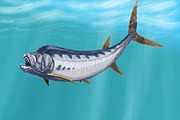 |
|||
Cartilaginous Fish
| Cartilaginous fish of the Campanian | ||||
|---|---|---|---|---|
| Taxa | Presence | Location | Description | Images |
Chlamydoselachus Chlamydoselachus Chlamydoselachus is a genus of sharks and the sole extant member of the family Chlamydoselachidae, in the order Hexanchiformes. It contains two extant and several extinct species.-Species:... |
 |
|||
†Schizorhiza Schizorhiza Schizorhiza is a fossil genus of cartilaginous fish, containing a single accepted species Schizorhiza stromeri. Its fossils are found in rocks dating from the Campanian and Maastrichtian stages; it thus lived between about 71 and 65.5 million years ago... |
||||
†Ceratopsians
| Ceratopsia Ceratopsia Ceratopsia or Ceratopia is a group of herbivorous, beaked dinosaurs which thrived in what are now North America, Europe, and Asia, during the Cretaceous Period, although ancestral forms lived earlier, in the Jurassic. The earliest known ceratopsian, Yinlong downsi, lived between 161.2 and 155.7... ns of the Campanian |
||||
|---|---|---|---|---|
| Taxa | Presence | Location | Description | Images |
Achelousaurus Achelousaurus Achelousaurus is a genus of centrosaurine ceratopsid dinosaurs from the Late Cretaceous Period of what is now North America, dated to 74 million years ago... |
 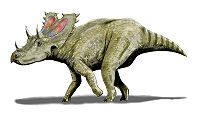 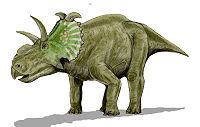 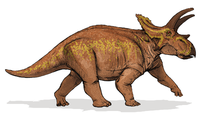 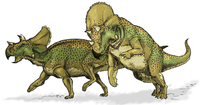  |
|||
Agujaceratops Agujaceratops Agujaceratops is a genus of herbivorous ceratopsian dinosaur. It is a chasmosaurine ceratopsian which lived during the Late Cretaceous period in what is now Texas. Originally known as Chasmosaurus mariscalensis and described by Lehman in 1989, it was moved to a new genus by Lucas, Sullivan and... |
||||
Albertaceratops Albertaceratops Albertaceratops was a genus of centrosaurine horned dinosaur from the middle Campanian-age Upper Cretaceous Oldman Formation of Alberta, Canada.... |
||||
Anchiceratops Anchiceratops Anchiceratops is a genus of chasmosaurine ceratopsid dinosaur from the Late Cretaceous Period of western North America. Like other ceratopsids, it was a quadrupedal herbivore with three horns on its face, a parrot-like beak, and a long frill extending from the back of its head. The two horns above... |
||||
Avaceratops Avaceratops Avaceratops is a genus of small ceratopsian dinosaur which lived during the late Campanian during the Late Cretaceous Period in what are now the Northwest United States.-Discoveries and species:... |
||||
Bagaceratops Bagaceratops Bagaceratops, meaning "small-horned face" , is a genus of ceratopsian dinosaur that lived in what is now Mongolia around 80 million years ago, during the Late Cretaceous... |
||||
Bainoceratops Bainoceratops Bainoceratops was a genus of dinosaur from the late Campanian in the Late Cretaceous. It was a ceratopsian first described by Tereschenko and Alifanov in 2003... |
||||
Brachyceratops Brachyceratops Brachyceratops is a dubious genus of ceratopsian dinosaur known only from partial juvenile specimens dating to the late Cretaceous Period of Montana, United States.... |
||||
Breviceratops Breviceratops Breviceratops was a ceratopsian dinosaur from Late Cretaceous Mongolia. It was related to Protoceratops. The fossils originally described by Maryanska and Osmolska in 1975 and placed in Protoceratops, were moved to the new genus by Kurzanov in 1990.The type species is Breviceratops... |
||||
Centrosaurus Centrosaurus Centrosaurus is a genus of herbivorous ceratopsian dinosaurs from the late Cretaceous of Canada. Their remains have been found in the Dinosaur Park Formation and uppermost Oldman Formation, dating from 76.5 to 75.5 million years ago.... |
||||
Cerasinops Cerasinops Cerasinops was a small ceratopsian dinosaur. It lived during the Campanian of the late Cretaceous Period. Its fossils have been found in Two Medicine Formation, in Montana.... |
||||
Chasmosaurus Chasmosaurus Chasmosaurus is a genus of ceratopsid dinosaur from the Upper Cretaceous Period of North America. Its name means 'opening lizard', referring to the large openings in its frill . With a length of and a weight of , Chasmosaurus was a ceratopsian of average size... |
||||
?Dysganus Dysganus Dysganus is the name given to a dubious genus of dinosaur from the Late Cretaceous. It was a ceratopsian. Its fossils have been found in Montana.... |
||||
Einiosaurus Einiosaurus Einiosaurus is a medium-sized centrosaurine ceratopsian from the Upper Cretaceous of northwestern Montana. The name means 'buffalo lizard', in a combination of Blackfeet Indian and Latinized Ancient Greek; the specific name Einiosaurus is a medium-sized centrosaurine (“short-frilled”)... |
||||
Graciliceratops Graciliceratops Graciliceratops is a Ceratopsian dinosaur first described by paleontologist Paul Sereno in 2000. It is known from the Late Cretaceous period and its fossils were found in Mongolia... |
||||
Lamaceratops Lamaceratops Lamaceratops,"Lama Horned Face", is a dinosaur from the Late Cretaceous period. It is classified as a ceratopsian, a herbivorous "frilled" or armored dinosaur similar to, but smaller than, Bagaceratops. It had a horn on the front of its face, much like most of the later Ceratopsids.The fossils of... |
||||
Magnirostris Magnirostris Magnirostris, from the Latin "magnus" 'large' and "rostrum" 'beak', is the name given to a genus of dinosaur from the Late Campanian epoch in the Late Cretaceous. It was a ceratopsian which lived in Inner Mongolia in China... |
||||
Medusaceratops Medusaceratops Medusaceratops is a genus of herbivorous ceratopsian dinosaur. It is a chasmosaurine ceratopsian which lived during the Late Cretaceous period in what is now Montana. It is known from two partial parietals, the holotype WDC DJR 001 and the paratype WDC DJR 002... |
||||
Monoclonius Monoclonius Monoclonius was a ceratopsian dinosaur from the Judith River Formation of Late Cretaceous Montana and Canada. It is often confused with Centrosaurus, a similar genus of ceratopsian . Monoclonius was described by Edward Drinker Cope in 1876... |
||||
Prenoceratops Prenoceratops Prenoceratops, is a genus of ceratopsian dinosaur from the Late Cretaceous Period. Its fossils have been found in the Two Medicine Formation in the present-day U.S. state of Montana... |
||||
Platyceratops Platyceratops Platyceratops is a dinosaur from the Late Cretaceous, during the Campanian Age, about 75-72 million years ago. Its fossils have been found in Mongolia. Its skull is larger than Bagaceratops; it has been referred to Bagaceratopidae or the Neoceratopsia... |
||||
Protoceratops Protoceratops Protoceratops is a genus of sheep-sized herbivorous ceratopsian dinosaur, from the Upper Cretaceous Period of what is now Mongolia. It was a member of the Protoceratopsidae, a group of early horned dinosaurs... |
||||
Styracosaurus Styracosaurus Styracosaurus was a genus of herbivorous ceratopsian dinosaur from the Cretaceous Period , about 76.5 to 75.0 million years ago... |
||||
Torosaurus Torosaurus Torosaurus is a genus of ceratopsid dinosaur that lived during the late Cretaceous period , between 70 and 65 million years ago. It possessed one of the largest skulls of any known land animal. The frilled skull reached in length... |
||||
Udanoceratops Udanoceratops Udanoceratops is a genus of ceratopsian dinosaur. It lived during the Late Cretaceous Period in the late Santonian or early Campanian faunal stages... |
||||
Crocodylomorphs
| Crocodylomorphs of the Campanian | ||||
|---|---|---|---|---|
| Taxa | Presence | Location | Description | Images |
|
||||
Mammals
| Mammals of the Campanian | ||||
|---|---|---|---|---|
| Taxa | Presence | Location | Description | Images |
Alphadon Alphadon Alphadon was a genus of small, primitive mammal that was a member of the metatherians, a group of mammals that includes modern-day marsupials. Its fossils were first discovered and named by George Gaylord Simpson in 1929.... |
||||
Didelphodon Didelphodon Didelphodon is a genus of stagodont marsupials from the Late Cretaceous of North America. Three species are known: Didelphodon vorax, D. padanicus, and D. coyi. Although perhaps little larger than a Virginia Opossum, it was one of the largest mammals of the Mesozoic... |
||||
Kamptobaatar Kamptobaatar Kamptobaatar is a Mongolian mammal genus from the Upper Cretaceous. It lived at the same time as the later dinosaurs. This animal was a member of the extinct order Multituberculata within the suborder Cimolodonta and family Sloanbaataridae.... |
||||
Kennalestes Kennalestes Kennalestes gobiensis is an extinct species of insectivoreous mammal resembling a shrew. It was a common mammal in Mongolia during the Cretaceous period, found in both the Bayan Mandahu Formation and Djadochta Formation.... |
||||
Zalambdalestes Zalambdalestes Zalambdalestes was a placental mammal living during the Upper Cretaceous in Mongolia. It is one of the oldest examples of a placental mammal known, and would have lived alongside the dinosaurs.... |
||||
†Ornithopods
| Ornithopods of the Campanian | ||||
|---|---|---|---|---|
| Taxa | Presence | Location | Description | Images |
Aralosaurus Aralosaurus Aralosaurus meaning "Aral Sea lizard", because it was found in the Aral Sea was a genus of hadrosaurid dinosaur which lived during the Late Cretaceous of what is now Kazakhstan... |
    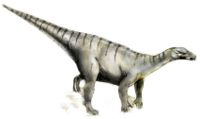  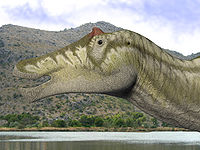   |
|||
Brachylophosaurus Brachylophosaurus Brachylophosaurus was a mid-sized member of the hadrosaurid family of dinosaurs. It is known from several skeletons and bonebed material from the Judith River Formation of Montana and the Oldman Formation of Alberta, living about 76.5 million years ago.... |
||||
Corythosaurus Corythosaurus Corythosaurus is a genus of duck-billed dinosaur from the Upper Cretaceous Period, about 77-76.5 million years ago. It lived in what is now North America... |
||||
Diclonius Diclonius Diclonius is a genus of dinosaur from the Late Cretaceous. It was a hadrosaur based solely on teeth. Its fossils have been found in North America. The name is in reference to the method of tooth replacement, in which newly erupting replacement teeth could be in functional use at the same time as... |
||||
Edmontosaurus Edmontosaurus Edmontosaurus is a genus of crestless hadrosaurid dinosaur. It contains two species: Edmontosaurus regalis and Edmontosaurus annectens. Fossils of E. regalis have been found in rocks of western North America that date from the late Campanian stage of the Cretaceous Period 73 million years ago,... |
||||
Gasparinisaura Gasparinisaura Gasparinisaura is a genus of ornithopod dinosaur from the Late Cretaceous. Its fossils were found in Argentina. The type species, Gasparinisaura cincosaltensis, was described in 1996 by Coria and Salgado. Originally classified as an iguanodont, recent research indicates it is more basal... |
||||
Gilmoreosaurus Gilmoreosaurus Gilmoreosaurus is the name given to a genus of dinosaur from the Cretaceous of Asia. The type species is Gilmoreosaurus mongoliensis. It is believed to be a hadrosaur or iguanodont from the Iren Dabasu Formation of Mongolia, dating to 70 Ma ago. Additional specimens have been described as distinct... |
||||
Gryposaurus Gryposaurus Gryposaurus was a genus of duckbilled dinosaur that lived about 83 to 75.5 million years ago, in the Late Cretaceous of North America... |
||||
Hadrosaurus Hadrosaurus Hadrosaurus is a valid genus of hadrosaurid dinosaur. In 1858, a skeleton of a dinosaur from this genus was the first dinosaur skeleton known from more than isolated teeth to be found in North America. In 1868, it became the first ever mounted dinosaur skeleton... |
||||
Hypacrosaurus Hypacrosaurus Hypacrosaurus was a genus of duckbill dinosaur similar in appearance to Corythosaurus. Like Corythosaurus, it had a tall, hollow rounded crest, although not as large and straight... |
||||
Hypsibema Hypsibema Hypsibema is a little-known genus of dinosaur from the Late Cretaceous . Its giant fossils were found in the U.S. states of North Carolina and Missouri... |
||||
Kritosaurus Kritosaurus Kritosaurus is an incompletely known but historically important genus of hadrosaurid dinosaur. It lived about 73 million years ago, in the Late Cretaceous of North America... |
||||
Lambeosaurus Lambeosaurus Lambeosaurus is a genus of hadrosaurid dinosaur that lived about 76 to 75 million years ago, in the Late Cretaceous Period of North America. This bipedal/quadrupedal, herbivorous dinosaur is known for its distinctive hollow cranial crest, which in the best-known species resembled a hatchet... |
||||
Lophorhothon Lophorhothon Lophorhothon is a genus of hadrosauroid dinosaur from the Late Cretaceous, the first genus of dinosaur discovered in Alabama.-Discovery and naming:... |
||||
Maiasaura Maiasaura Maiasaura is a large duck-billed dinosaur genus that lived in the area currently covered by the state of Montana in the Upper Cretaceous Period , about 74 million years ago.... |
||||
Mandschurosaurus Mandschurosaurus Mandschurosaurus is a hadrosaur taxon based on material from the Upper Cretaceous of Belye Kruchi, Manchuria. M. amurensis is based on a poorly preserved and incomplete skeleton collected by Russian scientists in 1914 from the banks of the Amur River... |
||||
Microhadrosaurus Microhadrosaurus Microhadrosaurus is a genus of duckbill dinosaur from the Campanian or Maastrichtian-age Upper Cretaceous Yuanpu Formation of Guangdong, China... |
||||
Mochlodon Mochlodon Mochlodon is a genus of iguanodont dinosaur from the Late Cretaceous.In 1859 coal mine administrator Pawlowitsch notified the University of Vienna that some fossils had been found in the Gute Hoffnung mine at Muthmannsdorf in Austria... |
Austria | A rhabdodontid | ||
Naashoibitosaurus Naashoibitosaurus Naashoibitosaurus is a genus of hadrosaurid dinosaur that lived about 73 million years ago, in the Late Cretaceous, and was found in the Kirtland Formation of the San Juan Basin in New Mexico, United States. Only a partial skeleton has been found to date... |
||||
Nipponosaurus Nipponosaurus Nipponosaurus is a lambeosaurine hadrosaurid from Asia.The holotype was discovered in November 1934 during the construction of a hospital for the Kawakami colliery of the Mitsui Mining Company on Karafuto Prefecture , and additional material belonging to the specimen was recovered... |
||||
Orodromeus Orodromeus Orodromeus is a genus of herbivorous ornithopod dinosaur from the Late Cretaceous of North America.-Discovery and naming:... |
||||
Parasaurolophus Parasaurolophus Parasaurolophus is a genus of ornithopod dinosaur that lived in what is now North America during the Late Cretaceous Period, about 76.5–73 million years ago. It was an herbivore that walked both as a biped and a quadruped. Three species are recognized: P. walkeri , P. tubicen, and the... |
||||
Prosaurolophus Prosaurolophus Prosaurolophus is a genus of hadrosaurid dinosaur from the Late Cretaceous of North America. It is known from the remains of at least 25 individuals belonging to two species, including skulls and skeletons, but it remains obscure... |
||||
Pteropelyx Pteropelyx Pteropelyx is a dubious genus of Late Cretaceous hadrosaurid dinosaur from the Judith River Formation of Montana, named by Edward Drinker Cope in 1889. Historically, several species were assigned to it, all based on extremely fragmentary remains, but there is no evidence to support these assignments... |
||||
Rhabdodon Rhabdodon Rhabdodon is a genus of dinosaur that lived in Europe approximately 70 million years ago in the Late Cretaceous. It is unclear whether it was an iguanodont or a hypsilophodont, and may be a "missing link" between the two. Current evidence indicates it is an iguanodont similar to Tenontosaurus... |
France; Spain; Haţeg Island, Romania | It is unclear whether it was an iguanodont Iguanodont Iguanodonts were herbivorous dinosaurs that lived from the mid-Jurassic to Late Cretaceous. Some members include Camptosaurus, Callovosaurus, Iguanodon, Ouranosaurus, and the hadrosaurids or "duck-billed dinosaurs". Iguanodonts were one of the first groups of dinosaurs to be found... or a hypsilophodont Hypsilophodont Hypsilophodonts were small ornithopod dinosaurs, regarded as fast, herbivorous bipeds on the order of 1–2 meters long . They are known from Asia, Australia, Europe, New Zealand, North America, and South America, from rocks of Middle Jurassic to late Cretaceous age... , and may be a "missing link" between the two. Current evidence indicates it is an iguanodont similar to Tenontosaurus Tenontosaurus Tenontosaurus is a genus of medium- to large-sized ornithopod dinosaur. The genus is known from the late Aptian to Albian ages of the middle Cretaceous period sediments of western North America, dating between 115 to 108 million years ago... . |
||
Saurolophus Saurolophus Saurolophus is a genus of large hadrosaurine duckbill that lived about 69.5-68.5 million years ago, in the Late Cretaceous of North America and Asia; it is one of the few genera of dinosaurs known from multiple continents. It is distinguished by a spike-like crest which projects up and back... |
||||
Shantungosaurus Shantungosaurus Shantungosaurus, meaning "Shandong Lizard", is a genus of saurolophine hadrosaurid dinosaurs found in the Late Cretaceous Wangshi Formation of the Shandong Peninsula in China.-Description:... |
||||
Tanius Tanius Tanius is a genus of hadrosauroid dinosaur. It lived in the Late Cretaceous of the People's Republic of China.The type species, named and described in 1929 by Carl Wiman, is Tanius sinensis. The generic name honours the Chinese paleontologist Tan Xichou... |
||||
Trachodon Trachodon Trachodon is a dubious genus of hadrosaurid dinosaur based on teeth from the Campanian-age Upper Cretaceous Judith River Formation of Montana, U.S.A... |
||||
Tsintaosaurus Tsintaosaurus Tsintaosaurus is a genus of hadrosaurid dinosaur from China. It was about long, tall and weighed 3 tons. The type species is T. spinorhinus, first described by C. C... |
||||
Velafrons Velafrons Velafrons is a genus of lambeosaurine hadrosaurid dinosaur from the Late Cretaceous of Mexico. It is known from a mostly complete skull and partial skeleton of a juvenile individual, with a bony crest on the forehead... |
||||
†Pachycephalosaurs
| Pachycephalosaurs of the Campanian | ||||
|---|---|---|---|---|
| Taxa | Presence | Location | Description | Images |
Alaskacephale Alaskacephale Alaskacephale was a genus of pachycephalosaurid dinosaur that lived in the late Campanian stage of the Late Cretaceous .... |
Prince Creek Formation Prince Creek Formation The Prince Creek Formation is a geological formation in Alaska with strata from the early Maastrichtian stage of the Upper Cretaceous, dating to between 70 and 69 million years ago... , Alaska, USA |
 |
||
Colepiocephale Colepiocephale Colepiocephale is a genus of pachycephalosaurid dinosaur from Late Cretaceous deposits of Alberta, Canada. It was collected from the Foremost Formation . The type species, C. lambei, was originally described by Sternberg , and later renamed by Sullivan in 2003. C... |
Alberta, Canada | The oldest known pachycephalosaurid | ||
Goyocephale Goyocephale Goyocephale is a genus of pachycephalosaurid dinosaur which lived during the Late Cretaceous period. It lived in what is now Mongolia.Goyocephale probably weighed 10–40 kg. The type species, Goyocephale lattimorei, was formally described by Perle, Maryañska, and Osmólka from an incomplete... |
Mongolia | |||
Gravitholus Gravitholus Gravitholus was a genus of dinosaur from the late Cretaceous period . It was a pachycephalosaur, a type of dinosaur with a thick skull made of hardened bone. It lived in what is now Alberta, Canada, and was described in 1979 by W. P. Wall and Peter Galton.The type species is Gravitholus albertae... |
||||
Hanssuesia Hanssuesia Hanssuesia is a genus of pachycephalosaurid dinosaur from the late Cretaceous period. It lived in what is now Alberta and Montana.Hanssuesia based on material originally named Troodon sternbergi by Barnum Brown and Erich Maren Schlaikjer in 1943. Later, it was transferred to Stegoceras as S.... |
Alberta, Canada; Montana, USA | Distinguished from other pachycephalosaurs by having a depressed parietal region, wide frontoparietal dome, broad nasal characteristics, reduced prefontal lobes, and a reduced parietosquamosal shelf. | ||
?Heishansaurus Heishansaurus Heishansaurus, meaning "Heishan lizard" after the area in China where it was discovered, is the name given to a dubious genus of dinosaur. First described in 1953 as a pachycephalosaur, this dinosaur may actually be an ankylosaur. The fossils, dating from the Late Cretaceous , are fragmentary, and... |
||||
Homalocephale Homalocephale Homalocephale is a genus of dinosaur belonging to the pachycephalosaurid family, which lived during the late Cretaceous period of what is now Mongolia, 80 million years ago. The genus was described in 1974 by Osmólska & Maryañska, and consists of a single species, H... |
Mongolia | Sporting a flat, wedge-shaped skull roof, Homalocephale was different from other pachycephalosaurs. | ||
?Micropachycephalosaurus Micropachycephalosaurus Micropachycephalosaurus is a monotypic genus of ornithischian dinosaur. It lived in Shandong Province, China during the Late Cretaceous period . The incomplete skeleton of the single specimen was found on a cliff southwest of Laiyang... |
||||
Ornatotholus |
||||
Prenocephale Prenocephale Prenocephale was a small pachycephalosaurid dinosaur genus from the Late Cretaceous and was similar in many ways to its close relative, Homalocephale, which may simply represent Prenocephale juveniles. Adult Prenocephale probably weighed around and measured around long... |
||||
Sphaerotholus Sphaerotholus Sphaerotholus is a genus of pachycephalosaurid dinosaur from the Upper Cretaceous of the western United States. To date, two species have been described: the type species, S. goodwini, from the Den-na-zin Member of the Kirtland Formation of San Juan County, New Mexico, and a second species, S... |
||||
Stegoceras Stegoceras Stegoceras is a genus of plant-eating pachycephalosaurid dinosaur that lived in what is now North America during the Late Cretaceous period.... |
||||
Tylocephale Tylocephale Tylocephale is a genus of pachycephalosaurid dinosaur from the Late Cretaceous Period. It was a herbivorous dinosaur estimated to have been about 1.4 metres in length... |
||||
Wannanosaurus Wannanosaurus Wannanosaurus is a genus of basal pachycephalosaurian dinosaur from the Campanian-age Upper Cretaceous Xiaoyan Formation, about 80 million years ago in what is now Anhui, China... |
||||
†Plesiosaurs
| Plesiosaurs of the Campanian | ||||
|---|---|---|---|---|
| Taxa | Presence | Location | Description | Images |
†Elasmosaurus Elasmosaurus Elasmosaurus + σαυρος sauros 'lizard') is a genus of plesiosaur with an extremely long neck that lived in the Late Cretaceous period , 80.5 million years ago.-Description:... |
Pierre Shale Pierre Shale The Pierre Shale is a geologic formation or series in the Upper Cretaceous which occurs east of the Rocky Mountains in the Great Plains, from North Dakota to New Mexico.... , Kansas, USA |
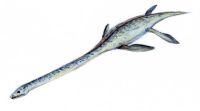  |
||
†Styxosaurus Styxosaurus Styxosaurus is a genus of plesiosaur of the family Elasmosauridae. Styxosaurus lived during the Santonian and Campanian age of the Cretaceous period.-Etymology:... |
||||
†Pterosaurs
| Pterosaurs of the Campanian | ||||
|---|---|---|---|---|
| Taxa | Presence | Location | Description | Images |
Nyctosaurus Nyctosaurus Nyctosaurus is a genus of pterodactyloid pterosaur, the remains of which have been found in the Niobrara Formation of the mid-western United States, which, during the late Cretaceous Period, was covered in an extensive shallow sea. The genus Nyctosaurus has had numerous species referred to it,... |
 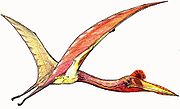 |
|||
Pteranodon Pteranodon Pteranodon , from the Late Cretaceous geological period of North America in present day Kansas, Alabama, Nebraska, Wyoming, and South Dakota, was one of the largest pterosaur genera and had a maximum wingspan of over... |
||||
Quetzalcoatlus Quetzalcoatlus Quetzalcoatlus was a pterodactyloid pterosaur known from the Late Cretaceous of North America , and one of the largest known flying animals of all time. It was a member of the Azhdarchidae, a family of advanced toothless pterosaurs with unusually long, stiffened necks... |
||||
†Sauropods
| Sauropods Sauropoda Sauropoda , or the sauropods , are an infraorder of saurischian dinosaurs. They had long necks, long tails, small heads , and thick, pillar-like legs. They are notable for the enormous sizes attained by some species, and the group includes the largest animals to have ever lived on land... of the Campanian |
||||
|---|---|---|---|---|
| Taxa | Presence | Location | Description | Images |
Alamosaurus Alamosaurus Alamosaurus is a genus of titanosaurian sauropod dinosaur from the Late Cretaceous Period of what is now North America. It was a large quadrupedal herbivore. Isolated vertebrae and limb bones indicate that it reached sizes comparable to Argentinosaurus and Puertasaurus, which would make it the... |
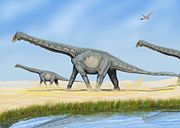  |
|||
Andesaurus Andesaurus Andesaurus is a genus of basal titanosaurian sauropod dinosaur which existed during the middle of the Cretaceous Period in South America. Like most sauropods, it would have had a small head on the end of a long neck and an equally long tail... |
||||
Bruhathkayosaurus Bruhathkayosaurus Bruhathkayosaurus might have been the largest dinosaur that ever lived. The accuracy of this claim, however, has been mired in controversy and debate... |
||||
Quaesitosaurus Quaesitosaurus Quaesitosaurus is a genus of titanosaurian sauropod found by Kurzanov and Bannikov in 1983. The type species is Quaesitosaurus orientalis. It lived from 85 to 70 million years ago during the Late Cretaceous... |
||||
Saltasaurus Saltasaurus Saltasaurus is a genus of titanosaurid sauropod dinosaur of the Late Cretaceous Period. Relatively small among sauropods, though still massive by the standards of modern creatures, Saltasaurus was characterized by a diplodocid-like head... |
||||
Squamates
| Squamates of the Campanian | ||||
|---|---|---|---|---|
| Taxa | Presence | Location | Description | Images |
Halisaurus Halisaurus Halisaurus is an extinct genus of marine lizard belonging to the mosasaur family. With a length of 3–4 m , it was small compared to most other mosasaurs. It was named by Othniel Charles Marsh in 1869, but renamed Baptosaurus by Marsh in 1870, who thought the name was already in use by a fish... |
 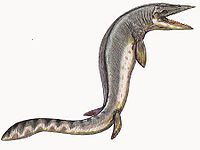 |
|||
Mosasaurus Mosasaurus Mosasaurus is a genus of mosasaur, carnivorous, aquatic lizards, somewhat resembling flippered crocodiles, with elongated heavy jaws. The genus existed during the Maastrichtian age of the Cretaceous period , around 70-65 millions years ago in the area of modern Western Europe and North America... |
||||
Plotosaurus Plotosaurus Plotosaurus is an extinct genus of mosasaur from the Upper Cretaceous of Fresno County, California. Originally named Kolposaurus by Berkeley paleontologist Charles Lewis Camp in 1942, it was changed to Plotosaurus in 1951 when Camp discovered the name had already been assigned to a type of... |
||||
Taniwhasaurus Taniwhasaurus Taniwhasaurus is an extinct genus of mosasaur, a carnivorous, marine reptile which inhabited New Zealand, Japan and Antarctica. The genus was a close relative of the genera Tylosaurus and Hainosaurus.-Species:-T... |
New Zealand, Japan, Antarctica | |||
Tylosaurus Tylosaurus Tylosaurus was a mosasaur, a large, predatory marine lizard closely related to modern monitor lizards and to snakes.-Paleobiology:... |
||||
Testudines
| Testudines of the Campanian | ||||
|---|---|---|---|---|
| Taxa | Presence | Location | Description | Images |
†Archelon Archelon Archelon is a genus of extinct sea turtle, the largest that has ever been documented.-Discovery:... |
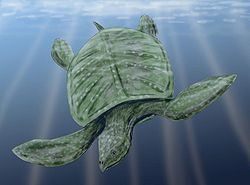 |
|||
†Theropods (non-avian)
David J. Varrichio observes that during the late Campanian Alberta and Montana had very similar theropods despite significant differences in the types of herbivorous dinosaur faunas.| Non-avian theropods Theropoda Theropoda is both a suborder of bipedal saurischian dinosaurs, and a clade consisting of that suborder and its descendants . Dinosaurs belonging to the suborder theropoda were primarily carnivorous, although a number of theropod groups evolved herbivory, omnivory, and insectivory... of the Campanian |
||||
|---|---|---|---|---|
| Taxa | Presence | Location | Description | Images |
|
Allen Formation Allen Formation The Allen Formation is a geological formation in Argentina whose strata date back to the Late Cretaceous The Allen Formation is a geological formation in Argentina whose strata date back to the Late Cretaceous The Allen Formation is a geological formation in Argentina whose strata date back to the... ?, Anacleto Formation Anacleto Formation The Anacleto Formation is a geologic formation with outcroppings in the Argentine Patagonian provinces of Mendoza, Río Negro, and Neuquén. It is the youngest formation within the Neuquén Group and belongs to the Río Colorado Subgroup... ?, Argentina |
Bipedal carnivore that probably reached 7 to 9 meters in length; known from only one partial skull. |
 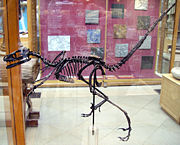 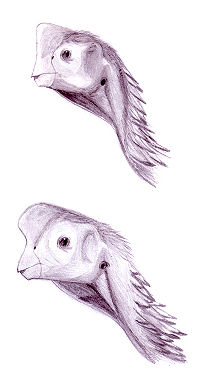 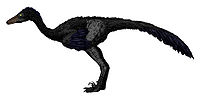 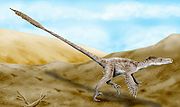 |
|
Albertosaurus Albertosaurus Albertosaurus is a genus of tyrannosaurid theropod dinosaur that lived in western North America during the Late Cretaceous Period, more than 70 million years ago. The type species, A. sarcophagus, was apparently restricted in range to the modern-day Canadian province of Alberta, after which... |
||||
Appalachiosaurus Appalachiosaurus Appalachiosaurus is a genus of tyrannosauroid theropod dinosaur from the Late Cretaceous Period of eastern North America. Like almost all theropods, it was a bipedal predator. Only a juvenile skeleton has been found, representing an animal over 7 meters long and weighing over... |
||||
Archaeornithomimus Archaeornithomimus Archaeornithomimus is a genus of ornithomimosaurian theropod dinosaur from the Late Cretaceous of China, 70 million years ago.... |
||||
Bambiraptor Bambiraptor Bambiraptor is a Late Cretaceous, 75 million year old, bird-like dromaeosaurid theropod dinosaur described by scientists at the University of Kansas, Yale University, and the University of New Orleans.... |
||||
Byronosaurus Byronosaurus Byronosaurus is a genus of troodontid dinosaur which lived during the Late Cretaceous Period. It was named for Byron Jaffe, "in recognition of his family's support for the Mongolian Academy of Sciences-American Museum of Natural History Paleontological Expeditions." The first example of... |
||||
Citipati Citipati Citipati is a genus of oviraptorid theropod dinosaur from the Late Cretaceous Period of what is now Mongolia . It is one of the best-known oviraptorids, thanks to a number of well-preserved skeletons, including several specimens found in brooding positions atop nests of eggs... |
||||
Carnotaurus Carnotaurus Carnotaurus was a large predatory dinosaur. Only one species, Carnotaurus sastrei has been described so far.Carnotaurus lived in Patagonia, Argentina during the Campanian or Maastrichtian stage of the Late Cretaceous... |
||||
Daspletosaurus Daspletosaurus Daspletosaurus is a genus of tyrannosaurid theropod dinosaur that lived in western North America between 77 and 74 million years ago, during the Late Cretaceous Period. Fossils of the only named species were found in Alberta, although other possible species from Alberta and Montana await... |
||||
Dromaeosaurus Dromaeosaurus Dromaeosaurus was a genus of theropod dinosaur which lived during the Late Cretaceous period , sometime between 76.5 and 74.8 million years ago, in the western United States and Alberta, Canada. The name means 'running lizard'.... |
||||
Dromiceiomimus |
||||
Dryptosaurus Dryptosaurus Dryptosaurus was a genus of primitive tyrannosaur that lived in Eastern North America during the middle Maastrichtian stage of the Late Cretaceous period. Although largely unknown now outside of academic circles, a famous painting of the genus by Charles R... |
||||
Gorgosaurus Gorgosaurus Gorgosaurus is a genus of tyrannosaurid theropod dinosaur that lived in western North America during the Late Cretaceous Period, between about 76.5 and 75 million years ago. Fossil remains have been found in the Canadian province of Alberta and possibly the U.S. state of Montana.... |
||||
Harpymimus Harpymimus Harpymimus is a basal ornithomimosaurian theropod dinosaur from the Early Cretaceous Period of what is now Mongolia. Unlike later, more derived ornithomimosaurs, Harpymimus still possessed teeth, although they appear to have been restricted to the dentary of the lower jaw.-Discovery and naming:In... |
||||
Khaan Khaan Khaan was an oviraptorid dinosaur that was found in the Djadochta Formation of Mongolia and lived in the Late Cretaceous Period , 75 million years ago.... |
||||
Luanchuanraptor Luanchuanraptor Luanchuanraptor is a genus of dromaeosaurid theropod dinosaur from the Late Cretaceous of China. It is based on a partial skeleton from the Qiupa Formation in Luanchuan, Henan. A medium-sized dromaeosaurid, it is the first Asian dromaeosaurid described from outside the Gobi Desert or northeastern... |
||||
Mononykus Mononykus Mononykus was a theropod dinosaur from late Cretaceous Mongolia with long, skinny legs. It moved about on two legs, was very nimble, and could run at high speeds, something that would have been useful in the open desert plains where it lived... |
||||
Noasaurus Noasaurus Noasaurus is the name given to a carnivorous dinosaur genus of the late Campanian-Maastrichtian... |
||||
Ornithomimus Ornithomimus Ornithomimus is a genus of ornithomimid dinosaur from the Late Cretaceous Period of what is now North America.In 1890 Ornithomimus velox was named by Othniel Charles Marsh on the basis of a foot and partial hand from the Maastrichtian Denver Formation. Another seventeen species have been named since... |
||||
Oviraptor Oviraptor Oviraptor is a genus of small Mongolian theropod dinosaur, first discovered by the paleontologist Roy Chapman Andrews, and first described by Henry Fairfield Osborn, in 1924... |
||||
Pyroraptor Pyroraptor Pyroraptor is a genus of dromaeosaurid dinosaur from the late Cretaceous Period of France. It is known from a single specimen. It was found in 1992 in the south of France, in Provence, and is known only from a few bones. It was named Pyroraptor olympius by Allain and Taquet in 2000. The name means... |
||||
Saurornithoides Saurornithoides Saurornithoides is a genus of troodontid maniraptoran dinosaur, living during the Late Cretaceous period. These creatures were predators, which could run fast on their hind legs and had excellent sight and hearing... |
||||
Saurornitholestes Saurornitholestes Saurornitholestes is a genus of carnivorous dromaeosaurid theropod dinosaur from the late Cretaceous of Alberta, Montana and New Mexico.... |
||||
Shuvuuia Shuvuuia Shuvuuia is a genus of bird-like theropod dinosaur from the late Cretaceous period of Mongolia. It is a member of the family Alvarezsauridae, small coelurosaurian dinosaurs which are characterized by short but powerful forelimbs specialized for digging. The type species is Shuvuuia deserti, or... |
||||
Struthiomimus Struthiomimus Struthiomimus is a genus of ornithomimid dinosaur from the late Cretaceous of Alberta, Canada. It was a long-legged, ostrich-like dinosaur.The bipedal Struthiomimus stood about long and tall at the hips and weighed around... |
||||
Troodon Troodon Troodon is a genus of relatively small, bird-like dinosaur from the Late Cretaceous period . Discovered in 1855, it was among the first dinosaurs found in North America... |
||||
Variraptor Variraptor Variraptor is a genus of coelurosaurian theropod dinosaur from the Late Cretaceous of France.Between 1992 and 1995 amateur paleontologists Patrick Méchin and Annie Méchin-Salessy uncovered the remains of a small theropod in the Grès à Reptiles Formation at La Bastide Neuve, near Fox-Amphoux... |
||||
Velociraptor Velociraptor Velociraptor is a genus of dromaeosaurid theropod dinosaur that existed approximately 75 to 71 million years ago during the later part of the Cretaceous Period. Two species are currently recognized, although others have been assigned in the past. The type species is V. mongoliensis; fossils... |
||||
Xenotarsosaurus Xenotarsosaurus Xenotarsosaurus is a genus of abelisaurid theropod dinosaur that lived during the Late Cretaceous of Argentina.In 1980 geologist Juan Carlos Sciutto discovered a rich fossil site six kilometres north of the Ocho Hermanos ranch in Chubut province. Among the fossils found there were some theropod... |
||||
External links
- GeoWhen Database - Campanian
- Late Cretaceous timescale, at the website of the subcommission for stratigraphic information of the ICS
- Stratigraphic chart of the Late Cretaceous, at the website of Norges Network of offshore records of geology and stratigraphy
- Campanian Microfossils: 75+ images of Foraminifera

